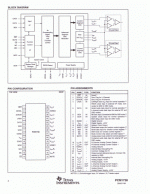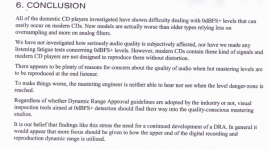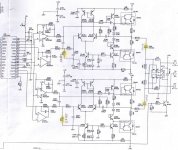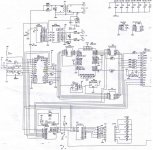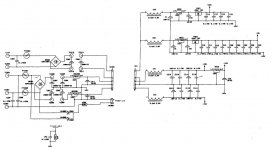I've just listened again on my Martin Logan ESL's and they give a very pure undistorted sine wave sound at -10db or -5db digital, no matter how loud I play it (to almost ear splitting level).
Then at 0db digital no matter how quite I set the volume the 1k sine wave has a slight ringing overtone to it that should not be there. It is obvious to me that the Burr Brown PCM1738 d/a chip is just, and I mean just, going into overload.
I then did the same on a pair of Stenhiser non-electrostatic headphones and the same thing is heard although not as cleanly, but it's there.
Cheers George
Then at 0db digital no matter how quite I set the volume the 1k sine wave has a slight ringing overtone to it that should not be there. It is obvious to me that the Burr Brown PCM1738 d/a chip is just, and I mean just, going into overload.
I then did the same on a pair of Stenhiser non-electrostatic headphones and the same thing is heard although not as cleanly, but it's there.
Cheers George
Hi George,
With digital electronics, when you run out of 1's or 0's, that's called clipping. Sorry to sound glib, but that's the truth of it. They would have to add a couple more positions at the MSB end of the word just to accomodate this. The true problem as I see it are the results of the math with the filter. You are going to get these effects, therefore you would need a longer word, but at the MSB end as I mentioned.
Of course they could always shift everything sideways so we lose a couple bits of resolution. Guess which way they would go.
-Chris
With digital electronics, when you run out of 1's or 0's, that's called clipping. Sorry to sound glib, but that's the truth of it. They would have to add a couple more positions at the MSB end of the word just to accomodate this. The true problem as I see it are the results of the math with the filter. You are going to get these effects, therefore you would need a longer word, but at the MSB end as I mentioned.
Of course they could always shift everything sideways so we lose a couple bits of resolution. Guess which way they would go.
-Chris
anatech said:Hi George,
Of course they could always shift everything sideways so we lose a couple bits of resolution. Guess which way they would go.
-Chris
So correct me if I'm wrong but most of us are using 24bit dacs these days (except for the TDA crew) couldn't we afford to loose a couple of bits off the 24bits and still have 16bit resolution? There must be a solution to this inherent problem with the new world d/a chips.
Or must we resign to the fact that when a digital stream hits 0db we are going to hear slight distortion, and that we should live with it.
I say not and we must revolt against it, in the most loudest way possible
Cheers George
georgehifi said:
I've look at the data sheets of my Burr Brown convertor and also of AD convertors and nowhere can I find the spec of the overload point, whether it's at +10db, +6db or 0db. Wouldn't it be nice if a d/a manufcturer stated that their d/a chip has an overload margine of +20db above 0db
It would be nice if this spec was given with all d/a chips so we know, we all assume it must be fine at 0db, but what happens at +6db!!!!!!
Cheers George
It is obvious where a digital device overloads. A 16 bit digital audio device overloads at 0111 1111 1111 1111 for positive going values and for negative values it is 1000 0000 0000 0000. It has nothing to do with the manufacturer.The overload point is known to all. That others choose not to take this into account is not the fault of the manufacturer.
georgehifi said:
So correct me if I'm wrong but most of us are using 24bit dacs these days (except for the TDA crew) couldn't we afford to loose a couple of bits off the 24bits and still have 16bit resolution? There must be a solution to this inherent problem with the new world d/a chips.
Or must we resign to the fact that when a digital stream hits 0db we are going to hear slight distortion, and that we should live with it.
I say not and we must revolt against it, in the most loudest way possible
Cheers George
There is no problem as far as the D/A is concerned. It simply reproduces what it is sent. If the dac hits 0dBFS it is because the data sent is at 0dBFS.
Yes but what they're saying is the 0db going into the d/a chip can become +6db http://www.tcelectronic.com/media/nielsen_lund_2000_0dbfs_le.pdf
when converted to analog before it comes out and distorts the internal analog filters of the d/a chip.
So if it's happening inside the d/a chip then it is the responsiblity of the d/a chip manufacters to have their internal filters so they don't overload. It has to be their problem and not the recording industries because they are playing by the rules and not giving any more than 0db to the dac.
Cheers George
when converted to analog before it comes out and distorts the internal analog filters of the d/a chip.
So if it's happening inside the d/a chip then it is the responsiblity of the d/a chip manufacters to have their internal filters so they don't overload. It has to be their problem and not the recording industries because they are playing by the rules and not giving any more than 0db to the dac.
Cheers George
georgehifi said:Yes but what they're saying is the 0db going into the d/a chip can become +6db http://www.tcelectronic.com/media/nielsen_lund_2000_0dbfs_le.pdf
when converted to analog before it comes out and distorts the internal analog filters of the d/a chip.
So if it's happening inside the d/a chip then it is the responsiblity of the d/a chip manufacters to have their internal filters so they don't overload. It has to be their problem and not the recording industries because they are playing by the rules and not giving any more than 0db to the dac.
Cheers George
A D/A converter does not have internal analogue filters, that is an external circuit.
The paper refers to intersample peaks. If you are inept enough to set your recording levels so high that the samples either side of a peak are at 0dBFS, then it stands to reason that the D/A will hard clip when it attempts recreate the peak as it simply cannot exceed 0dBFS. It is a simple matter to set your levels to avoid this. This may be new to TC Electronics but it is well known in the video world. At the post-production facility where I worked we routinely set our A/D's to indicate clip at 18dB below 0dBFS. The paper refers to some engineers opting for 3dB below 0dBFS (see section 5.2).
A lot of that paper reads as a case of giving a dog a bad name and kicking it. If you are hard clipping heavily enough to produces square waves and all that that entails, and not notice it, you must be deaf. All of the sources of distortion given can be avoided simply by being competent.
rfbrw, I said, and a few times now that I hear a SLIGHT overtone at 0db digital, I said nothing about hard clipping, this SLIGHT overtone that can be heard is not great enough to be picked up by a good scope, yet it can JUST be heard, and is not present at lower than 0db digital levels no matter how loud it is played.
I'm tending to believe the guys who have vast experience in building and designing the T.C. Electronic equiptment.
I hope others who have test cd's in their kit with varying levels of 1k sine waves up to 0db can try this, because you would have to be deaf not to hear it.
Cheers George
And here's a block diagram of my D/A chip, I'm sure it says digital filter in there.
I'm tending to believe the guys who have vast experience in building and designing the T.C. Electronic equiptment.
I hope others who have test cd's in their kit with varying levels of 1k sine waves up to 0db can try this, because you would have to be deaf not to hear it.
Cheers George
And here's a block diagram of my D/A chip, I'm sure it says digital filter in there.
Attachments
"All of the sources of distortion given can be avoided simply by being competent."
Delete the 'simply'.
It is a sad fact today that many productions hit 0dBFS routinely,
and that even a lot of productions just slam through it, clipping hard for tens of consecutive samples.
The most gruesome I have encountered so far (I have not been looking) is Depeche Mode's The Singles 81-85, which looks and sounds like a chainsaw.
Another interesting case is Simple Minds' New Gold Dream. Having the LP, I got the CD as a kid when it was released in 1983 or whatever (and then had to wait another 6 years to play it ;-).
Much as the LP peaked once massively close to the end of side two, this CD too hit 0dBFS once, in the same spot.
Last month I obtained a recent pressing of the same album. It sounds louder, brighter, and each track now hits 0dBFS 100-200 times.
So 'simply' and 'competently' are not exactly verbs in the music production industry.
Delete the 'simply'.
It is a sad fact today that many productions hit 0dBFS routinely,
and that even a lot of productions just slam through it, clipping hard for tens of consecutive samples.
The most gruesome I have encountered so far (I have not been looking) is Depeche Mode's The Singles 81-85, which looks and sounds like a chainsaw.
Another interesting case is Simple Minds' New Gold Dream. Having the LP, I got the CD as a kid when it was released in 1983 or whatever (and then had to wait another 6 years to play it ;-).
Much as the LP peaked once massively close to the end of side two, this CD too hit 0dBFS once, in the same spot.
Last month I obtained a recent pressing of the same album. It sounds louder, brighter, and each track now hits 0dBFS 100-200 times.
So 'simply' and 'competently' are not exactly verbs in the music production industry.
WernerI have a cd in my collection that has to be turned up twice as loud as the average cd has to (about 3o;clock), it called the "Tony Dagcadi Trio" it is the cleanest most explosive "dynamicly" cd in my collection yet it is the quietest volume setting wise, at twice the volume setting for normal listening level.
Have we become obsessed with having volume setting at 7o'clock for ear splitting level and the distortion they produce because they hit the 0db point, and by the way this is with a passive preamp, god knows what the poor souls do with 50-100 times gain active preamps, they must be just of the zero bump stop on their volume controls.
Cheers George
Have we become obsessed with having volume setting at 7o'clock for ear splitting level and the distortion they produce because they hit the 0db point, and by the way this is with a passive preamp, god knows what the poor souls do with 50-100 times gain active preamps, they must be just of the zero bump stop on their volume controls.
Cheers George
rfbrw said:As I said it is all about competence. Note the d/a converter used by Sony.
rfbrw Then if the Sony 777 has the same d/a chip as my MF Dac the PCM1738, then the problem has to be after the d/a chip, in either the I/V opamp which I've changed from the NE5532 to 4 x AD825 which should be far better. Also I've done a dc coupling mod with offset adjustment 5k mulit turn pots.
Can anyone see what could be limiting in this I/V or output stage at 0db digital, remembering it cannot be seen on the scope.
Cheers George
Attachments
Hi George,
I can't read the resistor values to figure out how much gain that circuit has. For it to clip, you'd be putting out over 20 Vp-p. The darlington output transistors might be a bit slow, but I doubt they would cause your troubles. You need a 'scope right about now.
I do have a test CD that outputs 0 dB levels. I'll have to check a new CD player next time I see one. I have a feeling that your troubles are in the digital domain still.
-Chris
I can't read the resistor values to figure out how much gain that circuit has. For it to clip, you'd be putting out over 20 Vp-p. The darlington output transistors might be a bit slow, but I doubt they would cause your troubles. You need a 'scope right about now.
I do have a test CD that outputs 0 dB levels. I'll have to check a new CD player next time I see one. I have a feeling that your troubles are in the digital domain still.
-Chris
Can you plug an oscilloscope in the analog output of the CD player to see what's actually there ?
I managed a bit better rez on this one, try it, thanks Chris.anatech said:Hi George,
I can't read the resistor values to figure out how much gain that circuit has. For it to clip, you'd be putting out over 20 Vp-p. The darlington output transistors might be a bit slow, but I doubt they would cause your troubles. You need a 'scope right about now.
I do have a test CD that outputs 0 dB levels. I'll have to check a new CD player next time I see one. I have a feeling that your troubles are in the digital domain still.
-Chris
Cheers George
Attachments
You are assuming the 0db track was not recorded already clipped, however slight. Then again, the opamps may be driving the differential pair into slight clip.
rfbrw said:You are assuming the 0db track was not recorded already clipped, however slight. Then again, the opamps may be driving the differential pair into slight clip.
rfbrw The test discs i have and both do it are the Denon Audio Technical (not for sale to the public). and the Pier Varny classic from years gone by.
And Chris as I said in a previous post I've looked at the output loaded with 22k with a Tektronics scope and the 1k looks perfect as if it was my Teck generator producing the 1k sine wave and not the transport/dac combo, and it looks perfect whether it's -20 -10 or 0db tracks on both the test discs, but it definately can just be heard at the 0db level.
I'm at a wits end with this, I hope someone can see a problem with headroom in the I/V or output stage as that would be a better fix for me as I'm no good with the digital side of things.
Cheers George
- Status
- Not open for further replies.
- Home
- Source & Line
- Digital Source
- Can over loud cd's overload dacs ? (Jocko?)
